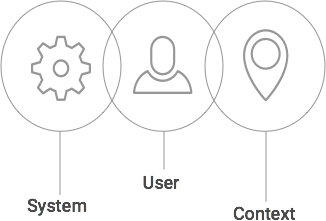I love helping people and improving their lives. I like to make a positive difference. I use my UX skills to discover the options available to meet people’s needs and goals.
My previous career was as an OH&S consultant. How is that connected to UX and the digital space, you might be wondering? That’s a fair question to ask.
Well, OH&S consultancy is problem solving in the physical space. Typical jobs involved me looking at physical environments and work systems. Key to these systems was recognising that the controls fail when you don’t take into account a worker’s motivations and goals. It is the psychology of work!
I became really good at observing and interviewing workers when visiting new environments. I’ll call this the research phase. Then comes the ideation phase involving reviewing my research notes alongside codes of practice and legislative requirements. After this is the creation phase where I typically was designing practical (implementable) solutions for clients. Implementation and iteration was normally in the hands of the client’s management team.
So I started thinking how I might apply these skills to the digital space. I found out about UX pretty much by accident (no pun intended!). My brother in law was working at a design agency as a web designer and mentioned one day that I should check out UX. I think his words were something like, “Hey Nigel, you know what? I think you might really enjoy UX”.
I pivoted in my career path and signed up to a full-time immersive course in General Assembly to focus on a design-thinking approach to user experience design. When considering UX, a product or service will fail when you don’t consider a user’s motivations and goals. This could be an app or a website or even a service.
In OH&S, I am not the worker and in UX, I am not the user.
I have always been fascinated with failure. I’ve moved on from thinking and dealing with safety failures (accidents and near misses) to considering failures in product or service design. Now, more than ever, I believe that a lean approach to product and service development, through research, ideation and rapid prototyping is the best way to deliver awesome results.
Every consultancy job in OH&S was a journey of discovery and I loved it! Not surprisingly, the biggest thrill I get in my UX journey is the discovery phase. As I have mentioned already, I love to ask ‘Why?’ I like to think, read, observe and take notes. The excitement is like going on a treasure hunt when you are a kid.
So where to start? In my experience, a good starting point is to try to understand the system, understand the user and understand the context. During this process I draw upon many influences and I use lots of post-its and paper.

When I have gathered lots of information I can more confidently define a problem in a problem statement and think about a solution statement. Carrying on from here into the research phase I can ask more informed questions in surveys and user interviews. This allows me to create personas and start thinking about a user journey.
At the same time I think about other organisations who might have solved similar problems and how they approached these challenges. Looking outwards at other companies informs my choice of competitors for a competitor analysis. As part of the competitor analysis I look at various heuristics, including the site navigation, broader site content and sometimes the entire site map.
Taking screenshots and annotating these helps me create an artboard for ideas. Considering a scenario and a task and then drawing a user flow, allows me to consider what’s happening and where the touch points might be.
From here, this influences my sketching as I work on post-its and paper and consider the various options. I like to seek feedback as early as possible to try remove any obvious problems and improve the design. I am always happy to scrap an idea and start again.
The next step might be wireframing or lo-fi prototyping. I can wireframe using lots of different applications. My current favourite is Sketch, which I really love although I am conscious of the limitations it has for handing assets to clients who don’t use Macs! I use the Pop app to make quick paper sketches clickable. I use Balsamiq to create clickable prototypes with higher fidelity and using branding assets. I use Axure RS to create high fidelity prototypes with beautiful interactions and even build in logic.